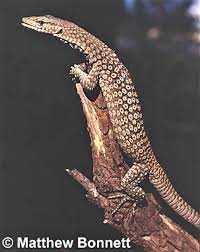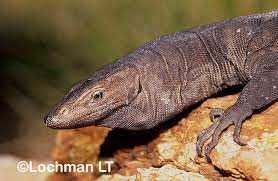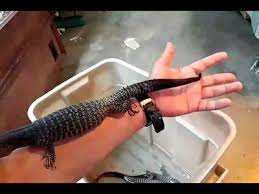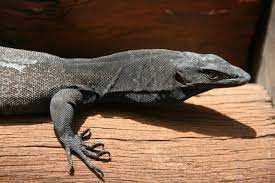
One of the most fascinating aspects of the Black Headed Monitor is its intelligence and problem-solving abilities. These lizards have been observed using tools to obtain food and navigate their environment, showcasing their adaptability and resourcefulness. Their cognitive capabilities make them highly interactive pets for those who are willing to provide the necessary care.
As a carnivorous reptile, the Black Headed Monitor’s diet consists primarily of small mammals, birds, frogs, and insects. Their strong jaws and sharp teeth allow them to catch and consume their prey with ease. It’s essential to provide them with a balanced diet that includes a variety of foods to ensure their nutritional needs are met.
Habitat and Natural Environment of Black Headed Monitor
The natural environment of the black-headed monitor plays a crucial role in its survival. It is a cold-blooded reptile, which means that it relies on external sources of heat to regulate its body temperature. In order to do so, it basks in the sun during the day and seeks shelter in burrows or under rocks to avoid extreme temperatures.
The black-headed monitor is also an excellent swimmer and can be found in areas near water bodies such as rivers, lakes, and swamps. It can effortlessly navigate through water and use it as a means of escape from predators or to search for food.
Being a top predator in its ecosystem, the black-headed monitor has few natural enemies. However, it still needs to be cautious of larger predators such as crocodiles and snakes. It has developed excellent climbing abilities to escape potential danger by seeking refuge in trees and tall vegetation.
Overall, the black-headed monitor has adapted well to its environment and continues to thrive in the diverse landscapes of Australia. Its ability to survive in various habitats is a testament to its resilience and adaptability.
Physical Characteristics and Appearance of Black Headed Monitor

The black-headed monitor gets its name from the distinctive black coloration on its head. The rest of its body is a pale grey to beige color, with dark spots scattered across its back and tail. It has a slender body shape and a long, thin tail, which aids in its agility and balance.
Adult black-headed monitors can reach lengths of up to 3 feet, with males typically being larger than females. Their body is covered in rough scales, which provide protection against predators and environmental hazards.
One of the most striking features of the black-headed monitor is its tongue, which is long and forked. This forked tongue helps the lizard detect its surroundings and locate prey by capturing scent particles in the air.
Habitat and Natural Environment

The black-headed monitor is found primarily in the arid regions of Australia, including the Northern Territory, Western Australia, and parts of Queensland. It prefers open habitats such as grasslands, woodlands, and scrublands.
These monitors are excellent climbers and are often found basking on rocks or perched on tree limbs. They have well-developed claws that allow them to grip onto surfaces and navigate their environment with ease.
Behavior and Diet
The black-headed monitor is a solitary and territorial predator. It has excellent eyesight and can spot prey from a distance. Its diet mainly consists of small mammals, birds, reptiles, insects, and eggs.
Overall, the black-headed monitor is a fascinating and unique reptile known for its striking appearance and predatory behavior. Its adaptability and ability to thrive in arid environments make it a remarkable species worthy of conservation efforts.
Diet and Feeding Habits of Black Headed Monitor
Being a carnivore, the black-headed monitor primarily feeds on a diet consisting of various smaller animals. Its diet includes insects, spiders, small birds, rodents, lizards, and even the eggs of other reptiles. The black-headed monitor is known for its ability to capture and consume prey that may be challenging for other predators.
While the black-headed monitor is capable of hunting its own food, it is also known to scavenge for carrion. This behavior allows it to take advantage of food sources that may be readily available, such as dead animals or discarded waste.
When hunting, the black-headed monitor utilizes its keen senses to locate its prey. Its excellent eyesight and sense of smell enable it to detect potential food sources from a distance. Once it identifies its prey, the black-headed monitor uses its speed and agility to capture and subdue it.
After capturing its prey, the black-headed monitor employs its sharp teeth and powerful jaws to tear apart its meal. It will consume the entire prey, including bones, fur, and feathers, as it lacks the ability to chew. This ability to consume the entire prey is a unique adaptation that allows it to extract as many nutrients as possible.
Since the black-headed monitor is a cold-blooded reptile, its diet and feeding habits are influenced by temperature and other environmental factors. During colder months, the black-headed monitor’s metabolism slows down, leading to decreased activity and a reduced appetite. Conversely, warmer temperatures increase its metabolic rate, leading to increased activity and a higher demand for food.
In captivity, it is crucial to replicate the black-headed monitor’s natural diet as closely as possible. A well-balanced diet for a captive black-headed monitor includes a variety of live prey, such as crickets, mealworms, mice, and small birds.
All About the Black Headed Monitor

Habitat and Natural Environment
The black headed monitor is primarily found in arid and semi-arid regions of Australia, including the Kimberley region, the Great Sandy Desert, and the southern parts of Western Australia. It prefers rocky habitats, such as gorges and cliff faces, and is often seen basking on exposed rocks or hiding in crevices.
This monitor is highly adaptable and can tolerate a wide range of temperatures. It is capable of adjusting its activity patterns and behavior based on the environmental conditions. During hot summers, it may become less active and seek shelter in cooler areas, while during cooler months, it may bask longer to maximize heat absorption.
Physical Characteristics and Appearance
The black headed monitor is a large lizard, with average adult males reaching a length of 70-90 centimeters. The females are slightly smaller, measuring around 60-80 centimeters. The body is elongated and slender, with a long tail that makes up about two-thirds of its total length.
Diet and Feeding Habits
Being a carnivorous reptile, the black headed monitor primarily feeds on a diet of small vertebrates, such as rodents, birds, lizards, and even other small monitors. It is an opportunistic hunter and will also scavenge on carrion if the opportunity arises. Juveniles mainly feed on insects and other invertebrates until they grow larger.
This monitor is an ambush predator and relies on its excellent eyesight and agility to capture its prey. It will often wait patiently near a potential food source and then strike with lightning speed, using its sharp teeth and powerful jaws to immobilize and consume its prey.
Reproduction and Breeding Behavior
The black headed monitor is a solitary reptile, and interaction between individuals is mainly restricted to mating. Breeding takes place during the warmer months, usually from September to November. Males engage in intense competition for females, engaging in aggressive displays and fights.
After successful mating, females will lay a clutch of 4-12 eggs in a shallow nest excavated in sandy soil or under a rocky ledge. The eggs are then covered and left to incubate for around 4-6 months. Once hatched, the young monitors are self-sufficient and need to fend for themselves.
The black headed monitor is a fascinating reptile with unique characteristics and behaviors. By providing the proper care and environment, reptile enthusiasts can enjoy the company of this remarkable lizard and witness its natural instincts and adaptive capabilities.
Interaction and Communication of the Black Headed Monitor
Body Language and Gestures
The Black Headed Monitor communicates through various body language and gestures. When threatened or sensing danger, it may puff up its body, flatten its tail, and hiss loudly as a warning. It also stands on its hind legs, trying to appear larger and more intimidating to potential predators. On the other hand, when feeling calm and relaxed, it may bask in the sun or simply stay motionless.
Tail Wagging
One of the unique communication behaviors of the Black Headed Monitor is tail wagging. This lizard often waves its tail side to side or up and down in a rhythmic manner, especially when it is excited or feels threatened. This behavior may serve as a visual signal to communicate its intentions or emotions to other monitors or animals in its vicinity.
Vocalizations
Although not as vocal as some other reptiles, the Black Headed Monitor does produce certain vocalizations. It can emit low growls, hissing sounds, or high-pitched squeaks. These vocalizations are often used during territorial disputes or conflicts with other monitors. Additionally, the male may produce specific vocalizations during courtship rituals to attract a female.
Scent Marking
Like many other lizards, the Black Headed Monitor uses scent marking to communicate with conspecifics. It has special glands located on its tail base, which secrete a musky scent. By rubbing its tail or body against objects or surfaces, it leaves its scent behind, marking its territory or leaving a trail for other monitors to follow.
Visual Displays
The Black Headed Monitor also utilizes visual displays to communicate. It can change the coloration of its skin, becoming darker or lighter, depending on its mood or surroundings. Additionally, it may use head bobs, body postures, or aggressive displays to communicate dominance, submission, or territorial boundaries to other monitors.
| Interaction and Communication of the Black Headed Monitor |
|---|
| Body Language and Gestures |
| Tail Wagging |
| Vocalizations |
| Scent Marking |
| Visual Displays |
All About the Black Headed Monitor: Lifespan and Health Care
Lifespan:
The average lifespan of the Black Headed Monitor in captivity is approximately 10 to 15 years. However, with proper care and optimal conditions, they can live up to 20 years or more. It is crucial to provide a suitable environment and meet their dietary needs to help maximize their lifespan.
Health Care:
Maintaining the health of a Black Headed Monitor requires attention to several key factors:
Diet: As carnivorous reptiles, Black Headed Monitors require a diet rich in protein. Their diet should consist primarily of insects, such as crickets, roaches, and mealworms. It is essential to provide a variety of insects to ensure a well-rounded and balanced diet. It is also recommended to occasionally offer small vertebrates, such as mice or baby birds, to replicate their natural feeding habits.
Enclosure: Black Headed Monitors need a spacious enclosure that mimics their natural habitat. The enclosure should be equipped with branches, rocks, and hiding spots to provide a stimulating environment. The temperature and humidity levels should be closely monitored and maintained within recommended ranges to promote their overall well-being.
Veterinary Care: Regular visits to a reptile veterinarian are essential for the health of your Black Headed Monitor. A veterinarian experienced in reptile care can provide guidance on diet, husbandry practices, and conduct regular check-ups. It is recommended to have a fecal sample tested annually to check for any potential parasites or infections.
Hygiene: Maintaining a clean enclosure is crucial to prevent the buildup of bacteria and promote good health. Regularly clean and disinfect the enclosure, remove feces, and provide fresh water daily. Keep an eye out for any signs of illness, such as loss of appetite, abnormal behavior, or skin issues, and consult a veterinarian if needed.
The Black Headed Monitor is a fascinating reptile species that requires dedicated care and attention. By providing them with a suitable environment, a balanced diet, and regular health check-ups, you can help ensure they live a long and healthy life.
Housing and Enclosure Requirements for Black Headed Monitor
Size of the Enclosure: The size of the enclosure should be a minimum of 8 feet long, 4 feet wide, and 6 feet tall. A larger enclosure is always better, as it allows the monitor to engage in natural behaviors such as climbing and basking.
Enclosure Type: Glass enclosures or specially designed reptile enclosures are suitable for housing black-headed monitors. Ensure that the enclosure has proper ventilation to maintain appropriate temperature and humidity levels.
Furnishing the Enclosure: Black-headed monitors require a variety of natural enrichment to keep them physically and mentally stimulated. Include branches, rocks, and hiding spots in the enclosure. Live plants can also be added to create a more natural and appealing environment.
Substrate: Use a suitable substrate such as cypress mulch, coconut coir, or newspaper for easy cleaning and maintenance. Avoid using substrates that can cause impaction if ingested, such as sand or gravel.
Temperature and Lighting: Maintain a temperature gradient in the enclosure, ranging from 85°F to 95°F at the basking spot and 75°F to 85°F in the cooler areas. Use a combination of heat lamps, ceramic heat emitters, and under-tank heaters to achieve and regulate the temperatures. Provide a UVB light source for 10 to 12 hours a day to ensure proper calcium metabolism.
Cleaning and Maintenance:
The enclosure should be cleaned regularly to maintain a hygienic living environment for the black-headed monitor. Remove feces, uneaten food, and any debris daily. Deep clean the enclosure monthly by replacing the substrate and disinfecting all surfaces with reptile-safe cleaners.
Monitoring and Behavioral Observation:
Regularly monitor the behavior and health of the black-headed monitor. Ensure that it is eating well, showing normal activity levels, and shedding its skin properly. Any signs of illness or abnormal behavior should be addressed promptly by consulting a reptile veterinarian.
Handling and Taming Black Headed Monitor: Tips and Techniques
As a natural predator, the black-headed monitor possesses sharp claws, strong jaws, and a muscular body. This makes handling them potentially challenging, especially during the initial stages of taming. However, with patience, consistency, and proper techniques, they can become quite docile and accustomed to human interaction.
1. Create a suitable environment: Before initiating any handling or taming process, it is crucial to ensure that the black-headed monitor has a comfortable and secure enclosure. A spacious terrarium with proper substrate, hiding spots, and basking areas is essential for their well-being.
2. Start with short sessions: During the initial stage of taming, it is recommended to keep handling sessions short and frequent. This allows the black-headed monitor to gradually become familiar with human presence and reduces the chances of stress or aggression.
3. Use gentle handling techniques: When handling a black-headed monitor, it is crucial to be gentle and avoid sudden movements. Approaching them from the side rather than from above can help reduce their stress levels. Supporting their body with both hands is essential to prevent dropping or causing discomfort.
4. Offer positive reinforcement: Offering food rewards and positive reinforcement can be an effective way to encourage trust and tame the black-headed monitor. By associating handling sessions with pleasant experiences, they are more likely to respond positively and gradually become more comfortable with human interaction.
6. Regular socialization: Regular socialization is key to maintaining a well-tamed black-headed monitor. Providing opportunities for supervised outdoor exploration, interaction with other reptiles, or even gentle exposure to new environments can help them become more adaptable and comfortable in different situations.
7. Seek professional guidance: If you encounter any difficulties in handling or taming your black-headed monitor, it is recommended to seek professional guidance from experienced reptile handlers or veterinarians. They can provide expert advice tailored to your specific circumstances and help address any behavior issues.
Conservation Status and Legal Protection of Black Headed Monitor
One of the major concerns regarding the conservation of black-headed monitors is habitat loss. As human populations continue to expand and develop land for various purposes, the natural habitats of these lizards are being destroyed. Deforestation, urbanization, and agricultural practices result in the loss of essential resources, such as suitable nesting sites, shelter, and prey availability.
In addition to habitat loss, the black-headed monitor faces another significant threat from invasive species. Predatory mammals and introduced reptiles pose a serious risk to the survival of these lizards. Many of these invasive species compete with black-headed monitors for food, territory, and other resources, often resulting in a decline in their population numbers.
The illegal pet trade also contributes to the decline of black-headed monitor populations. These lizards are highly sought after due to their attractive appearance and unique characteristics. Unregulated capture and trade of black-headed monitors has a detrimental impact on their wild populations, as it disrupts natural breeding and reduces the number of individuals in their native habitats.
To address these concerns and protect the black-headed monitor, various measures have been taken. The black-headed monitor is listed as a protected species in Australia, providing legal safeguards against capture, trade, and harm. Conservation organizations and government agencies work together to enforce these protective measures and raise awareness about the importance of conserving these reptiles.
Efforts are also being made to restore and conserve the natural habitats of black-headed monitors. Conservation projects aim to create protected areas, establish breeding programs, and conduct research to better understand their behavior, ecology, and population dynamics. Additionally, education and outreach programs are implemented to promote responsible pet ownership and discourage the illegal trade of black-headed monitors.
| Conservation status: | Least Concern |
|---|---|
| Legal protection: | Protected species in Australia |
| Main threats: | Habitat loss, invasive species, illegal pet trade |

I’m Lena Adams—a product of an unconventional upbringing in the African wilderness. My father, a daring explorer of African wildlife, sparked my fascination with reptiles, a passion that intertwined with the tragic loss of my mother during an expedition, leaving an indelible mark on my life. Driven to understand the creatures that captivated my parents, I embarked on my journey, sharing insights about reptiles, frogs, and lizards on my website. Through my explorations and conservation efforts, I honour my family’s legacy while seeking connections—to the creatures, nature, and the mother whose presence I yearn to understand.
